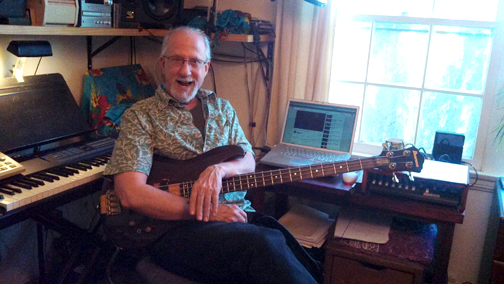
By Isiah REYES
After 30 years of holding one-on-one private music lessons, professional musician and music teacher Marty Buttwinick continues to find new avenues to deliver his knowledge, whether it is through new books or online videos.
Buttwinick has delivered over 40,000 hours of private lessons and consultations, played for thousands of events both small and large, led bands, recorded for film and television and prepared written music for local singers and international stars.
“One of the most gratifying things of teaching is leading the student to achieving a goal that they always wanted to attain but never thought they could,” Buttwinick said.
Buttwinick teaches all of his students in the comfort of his own home studio in Glendale, where he surrounds himself with a Kurzweil weighted digital keyboard, a spruced-up Fender-designed Squier Stratocaster, a cherry Ibanez musician bass that runs through a boutique tube bass amp, and a Roland drum machine that is perfect for teaching students since it is programmed with a variety of drum styles including Latin grooves.
When students are unable to attend lessons in person, Buttwinick is available via Skype or telephone. The types of lessons he creates are specifically tailored for the student’s own personal goals, whether it is to improve timing, write songs or just to understand music. He devised a module teaching method that consists of nine sections. Students only get what they need and they don’t get anything else.
“If a person doesn’t know what they want to learn, they have to be exposed to different things,” Buttwinick said.
Buttwinick teaches students how to learn and play all instruments at various levels. Lessons are one hour and an average of 15 to 20 students visit each week. All the paperwork for each student is saved meticulously. Even if a student returns after 15 years, he or she can pick up where they left off. Buttwinick also helps musicians who need career consultation and want to know how to start a band. He can answer important questions – like how to make money with music.
“I know all the ways musicians make money, either from my own experience or through surveys,” Buttwinick said.
For the most part, most of Buttwinick’s students are adults and teachers who have tried to learn on their own but couldn’t get what they needed or who just want to play an instrument for therapeutic reasons.
He has taught about 1,300 students. One, Chino Soto, has been learning to play guitar since around 2003. Soto did a search for guitar instructors in the area and after making a couple phone calls and having an initial consultation, he decided to take classes with Buttwinick in 2009.
“I can say that Marty’s method is unique as his feedback not only focuses on theory and rote drilling, but more on musical ability and intention,” Soto said. “He tailors his students’ curriculum based on our individual goals and abilities. More importantly, as an accomplished musician, teacher and composer, he inspires me to fulfill my passion in music.”
Soto has migrated to the Philippines and has continued lessons with Buttwinick over Skype. Buttwinick said the only shortcoming of online teaching is he hasn’t figured out a way to do real-time online jams. But he’s working on finding a cost-effective solution.
Now that the Internet has become a popular way to teach lessons online, Buttwinick has decided to take his lessons to YouTube. He said he has seen other YouTube instruction videos on how to play guitar and he doesn’t want to do what everyone else is doing. Instead, his videos fill in the niche gaps that help with little specialties that are not seen on YouTube. For example, his latest video is “How to Carry and Walk with an Upright Bass.”
Aside from making videos, which he edits himself, Buttwinick is also working on a few books. One is about the elements of melody and another is understanding popular sheet music. Currently he is editing a book on how to make money as a musician, which was originally released in 1995. When writing his books, Buttwinick hires surveyors to survey what people want to know.
He is also working on a guitar-driven CD, which he edits on GarageBand. A few singles have already been released and the album should make its way on iTunes by the holidays.
Bob Buckner, a student of Buttwinick, is a musician who plays and studies guitar. His lessons focus on clearing up any holes in his basic music foundation.
“I think Marty’s style of teaching is interesting,” Buckner said. “He always says he teaches students until a light bulb goes off and the student gets it. It’s happened to me a couple of times and I can see him waiting as if he is expecting you to get it.”
Another student is Michael Haussler who trains new teachers for a living and has also taught grad classes. He has been taking piano lessons once a week since February and had no experience in piano.
“Marty is an exceptional teacher,” Haussler said. “For Marty, teaching piano is more than teaching a technical skill. It is learning to understand and appreciate music as an art form. He can push hard when he needs to but even when he does, it is done in a spirit of learning, not judging.”
In addition to teaching beginning and intermediate students, Buttwinick has also taught students who have performed or recorded with Taylor Dane, Nine Inch Nails, Beck, Dixie Chicks, Edgar Winter, and Doug E. Fresh among others.
Despite the number of hours he puts in to teach his students how to play an instrument or how to navigate the music industry, Buttwinick shows no signs of slowing down when it comes to the devotion he has for teaching.
“I like helping people,” Buttwinick said. “I’m a good problem solver.”
